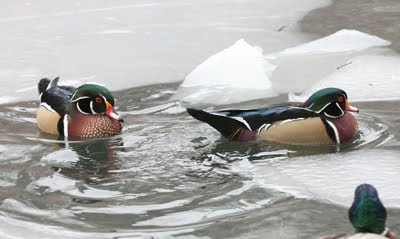I've been getting anxious emails from readers of this blog for a few weeks, usually with the words "Where is Lola?" in the subject line. Yesterday, the latest one came from Marsha Green of Angels Camp CA.
Hi Marie, I have been following your blog for about 7 years. I notice Lola has been MIA for some time. What does John Blakeman think?
I promptly sent the following email to the Ohio hawk expert I had consulted so many times in the past. I knew he followed Lincoln's PaleMale.com website, so I wouldn't need to include background explanations:
Dear John, As you must know, Lola was last seen on 12/18. Here's my question: In the past when one of Pale Male's mates disappeared, he came up with a new female within a week. Any ideas about why it should be different now? His age? The long time they've been a pair? Marie As in the past, Blakeman replied almost immediately. His response came before evidence of a new development in the Pale Male drama appeared on the PaleMale.com website today. The photo above was one of many in today's post demonstrating the prescient nature of Blakeman's email:
[note: Blakeman uses the falconry term "haggard" to refer to an adult hawk, and the term "formel" to indicate a female hawk. Both terms, in his letter below, refer to Pale Male's new mate]
Marie,
It's pretty clear that Lola has met her demise, probably from a poisoned prey animal (probably a rat), or by injury. This is not the season that experienced haggards cavalierly absent themselves from their established territories.
But why, then, no immediate replacement suitors? Why hasn't Pale Male accepted a new mate yet? I don't know. I think this is just some aspect of behavioral variability. It might be related to the rather cold and snowy winter, causing all of the hawks to focus on hunting. Pair bonding this early in this particular January may have been subordinated to hunting and food acquisition.
But I have no doubt this will soon change. There is a giant population of "floaters," un-paired young adults without territories. These birds wander around the greater landscape peering into existing red-tail territories, looking to see if a mate is missing. If so, they will fly right in and make themselves known to the remaining unpaired hawk, in this case Pale Male himself.
As the days begin to discernably lengthen, a matter that will soon be apparent to the hawks (if it isn't already), pair-bonding and mating impulses will overtake hunting interests. A new mate will appear, perhaps by the end of the week; certianly by the end of the month.
And yes, the new formel will use the nest Pale Male selects and attends to, the one at 927 Fifth Ave. The new haggard follows the lead and prompts of the existing territory resident. Pale Male will show the way clearly to his new mate.
--John Blakeman
PS: Another note from John Blakeman has just come in:
Marie,
I noticed on the PaleMale.com website this morning the very clear presence of a new mate, noting that it was seen early-on back in December. That's exactly what I would have predicted. All of this are typical mating behaviors of red-tails forming new pair bonds (but not copulation, which will come later).
Two interesting plumage matters. First, Pale Male has somehow lost the tips of his third and fourth left primaries. This little gap in the tip of his left wing will allow easy recognition during flight, until he replaces those feathers in the summer molt.
The new formel is just the opposite of Pale Male, Her head is markedly dark, with dark feathers wrapping around under her chin and on to the front of her neck. I'll leave it to creative New York types to come up with a descriptive name that might take this into account; a name I hope that that will parallel your wonderful name for Pale Male and his light-colored head.
I will be interested to see the eye color of the new formel. It's very likely to be not yet completely dark, indicating that the bird is in her third or fourth year, a young adult ready and eager to begin family life, and we hope with new eyasses.
--John Blakeman










